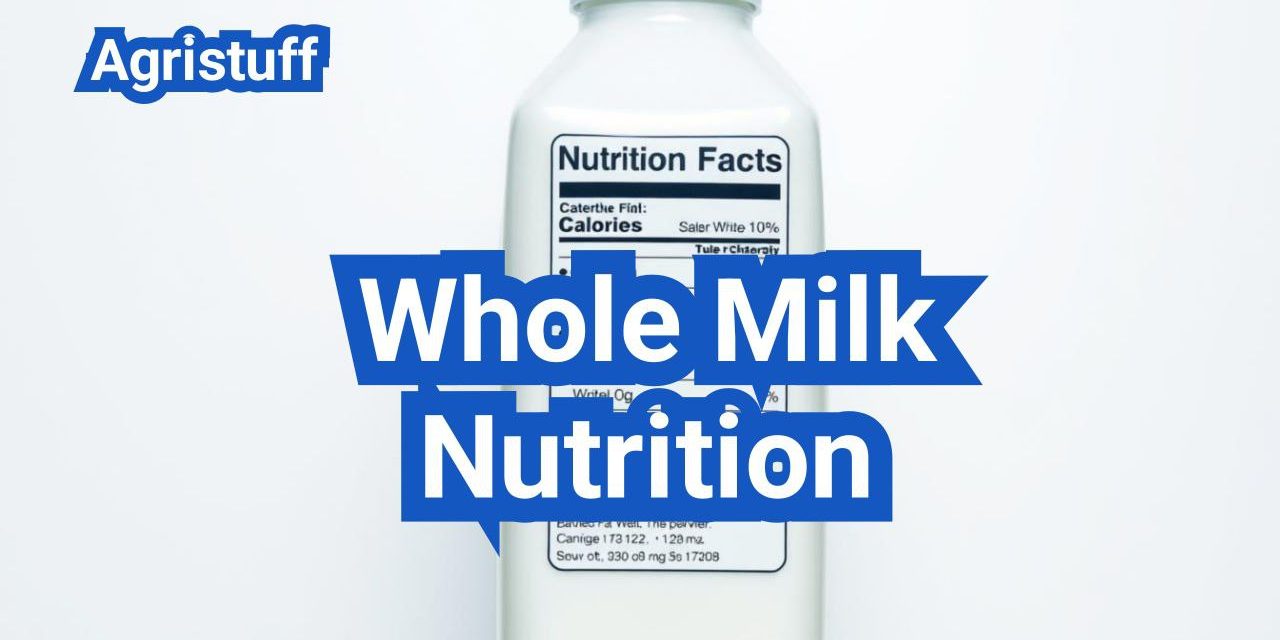This article does not contain medical advice
Cow’s milk has been a staple in many diets for centuries, providing essential vitamins, minerals, protein, and energy. Whole milk, in particular, contains about 3.25% milk fat, making it a rich source of calories and nutrients.
The nutritional value of whole milk is significant, with every serving providing a boost of vitamins and minerals. Understanding its nutritional content is crucial for making informed dietary choices.
Key Takeaways
- Whole milk contains about 3.25% milk fat, making it a rich source of calories and nutrients.
- Every serving of whole milk provides essential vitamins, minerals, protein, and energy.
- Understanding whole milk nutrition is crucial for making informed dietary choices.
- Whole milk can be a valuable part of a balanced diet when consumed in moderation.
- The nutritional benefits of whole milk include its high calorie and nutrient content.
What Is Whole Milk?
Unlike other types of milk, whole milk is closest to its natural state when it comes from the cow. It is characterized by its high fat content, which is not significantly altered during processing.
Definition and Processing Methods
Whole milk is defined as milk that contains its natural fat content, typically around 3.5%. The processing of whole milk involves pasteurization, where the milk is heated to kill bacteria, and sometimes ultra-high temperature (UHT) treatment for longer shelf life. Minimal processing helps retain its nutritional value.
Difference Between Whole Milk and Other Milk Types
The primary difference between whole milk and other types of milk, such as skim or 2% milk, lies in the fat content In contrast, reduced-fat milks have lower calorie counts but may have added vitamins or other nutrients.
Whole Milk Nutrition: Complete Nutritional Profile
Understanding the nutritional profile of whole milk is crucial for making informed dietary choices. Whole milk is a rich source of essential nutrients, including proteins, fats, and various vitamins and minerals.
Standard Serving Sizes Explained
Whole milk serving sizes are standardized to help consumers understand the nutritional content. A common serving size is 1 cup, which is equivalent to 8 ounces or 240 milliliters. Another standard measurement is 100 grams, which is used for detailed nutritional analysis.
Nutritional Value Per 100g
Per 100 grams, whole milk contains approximately 62 calories, 3.2 grams of protein, and 3.6 grams of fat. It is also a good source of calcium, vitamin D, and other essential nutrients.
Nutritional Value Per Cup (8 oz)
A one-cup serving (8 oz) of whole milk contains about 150 calories, 8 grams of protein, and 8 grams of fat. The exact nutritional content can vary slightly depending on the brand and processing methods.
As noted by a registered dietitian, “Whole milk is a nutrient-dense beverage that provides a significant amount of protein and calcium necessary for bone health.” This highlights the importance of whole milk in a balanced diet, particularly for children and adolescents.
To summarize, whole milk offers a rich nutritional profile that includes proteins, fats, and various essential vitamins and minerals. Understanding the nutritional content per serving size can help consumers make informed choices about their diet.
How to Read a Whole Milk Nutrition Label
Understanding the nutrition label on whole milk is crucial for making informed dietary choices. The label provides detailed information about the nutritional content, serving sizes, and key nutrients.
Understanding Serving Sizes
Serving sizes on nutrition labels are standardized to help consumers compare similar products. For whole milk, a standard serving size is typically one cup or 8 ounces. It’s essential to note that the nutritional information provided is based on this serving size.
Key Nutrients to Look For
When reading a whole milk nutrition label, look for the following key nutrients:
- Calories: Understand the calorie content per serving.
- Total Fat: Includes saturated and unsaturated fats.
- Protein: Essential for muscle repair and growth.
- Calcium: Crucial for bone health.
- Vitamin D: Important for bone health and immune function.
Comparing Labels Between Brands
Different brands may have slightly varying nutritional profiles due to differences in processing and fortification. Comparing labels can help you choose the whole milk that best fits your dietary needs. Pay attention to added vitamins, fat content, and protein levels.
Calorie Content in Whole Milk

The calorie content in whole milk is an essential aspect of its nutritional profile. Whole milk is often considered a significant source of calories due to its fat content.
Calories in Common Serving Sizes
A one-cup serving of whole milk contains approximately 150 calories. This serving size is standard for nutritional comparisons. Other common serving sizes include:
- 1 cup (8 oz) = 150 calories
- 1/2 cup (4 oz) = 75 calories
- 1 tablespoon = approximately 9 calories
How Whole Milk Calories Fit Into Daily Requirements
The daily calorie requirements vary based on factors such as age, sex, weight, and activity level. Generally, the recommended daily intake ranges from 1,600 to 2,400 calories for women and 2,000 to 3,000 calories for men.
Consuming whole milk as part of a balanced diet contributes to these daily calorie needs. For example, two cups of whole milk per day would account for approximately 300 calories, or about 15% of a 2,000 calorie diet.
Key Points to Consider:
- Whole milk calories can contribute significantly to daily intake.
- Serving sizes should be considered when calculating calorie intake.
- Balancing whole milk consumption with other dietary components is essential.
Understanding Fat Content in Whole Milk
Understanding the fat content in whole milk is essential for making informed dietary choices. Whole milk is characterized by its fat content, which is significantly higher compared to lower-fat milk varieties.
Total Fat Percentage in Whole Milk
Whole milk contains approximately 3.25% milk fat. This fat content contributes to its rich taste and nutritional profile. The total fat percentage is a critical factor in determining the calorie content and overall nutritional value of whole milk.
Saturated Fat Content and Health Implications
The fat in whole milk is primarily composed of saturated fats. Saturated fats have been a topic of debate regarding their health implications. While high intake of saturated fats is associated with increased risk of heart disease, whole milk also contains other nutrients that can have beneficial effects on health.
Beneficial Fats in Whole Milk
Besides saturated fats, whole milk contains other beneficial fatty acids. These include conjugated linoleic acid (CLA) and omega-3 fatty acids, which have been linked to various health benefits. The presence of these beneficial fats adds to the nutritional complexity of whole milk.
| Fat Type | Percentage in Whole Milk | Health Implications |
|---|---|---|
| Saturated Fat | Majority of fat content | Potential increased risk of heart disease |
| Conjugated Linoleic Acid (CLA) | Small percentage | Potential health benefits, including immune system support |
| Omega-3 Fatty Acids | Small percentage | Heart health benefits and anti-inflammatory effects |
In conclusion, the fat content in whole milk is a complex aspect of its nutritional profile, comprising both saturated fats and beneficial fatty acids. Understanding these components is crucial for assessing the role of whole milk in a balanced diet.
Protein and Carbohydrates in Whole Milk
In addition to its fat content, whole milk is an excellent source of protein and contains carbohydrates in the form of lactose. Understanding the protein and carbohydrate content can help consumers make informed decisions about their diet.
Protein Content and Quality
Whole milk contains about 8 grams of protein per 8 oz serving. The protein in whole milk is considered high-quality because it contains all essential amino acids necessary for the human body. These amino acids are crucial for muscle repair, growth, and overall health. The protein content in whole milk can be particularly beneficial for individuals looking to increase their protein intake, such as athletes or those on a high-protein diet.
Lactose and Sugar Content
The primary carbohydrate in whole milk is lactose, a naturally occurring sugar. Lactose is an important source of energy, particularly for the brain and nervous system. Whole milk contains approximately 12 grams of lactose per 8 oz serving. While some individuals may be lactose intolerant, for most people, lactose is easily digested and provides a quick source of energy.
Balancing Macronutrients in Your Diet
Balancing protein, carbohydrates, and fats is crucial for maintaining a healthy diet. Whole milk can be a valuable part of this balance, providing a mix of these macronutrients. Consumers can use whole milk as part of a balanced meal or snack, pairing it with other nutrient-dense foods to achieve a well-rounded diet. For example, combining whole milk with cereal or using it in smoothies with fruits and nuts can create a satisfying and nutritious meal.
Essential Vitamins and Minerals in Whole Milk

Whole milk is an excellent source of several key vitamins and minerals that support overall well-being. It is particularly renowned for its high content of calcium and vitamin D, but it also provides other essential nutrients.
Vitamin D and Calcium Content
Whole milk is a rich source of calcium and vitamin D, two nutrients that are crucial for bone health. Calcium is essential for building and maintaining strong bones and teeth, while vitamin D helps the body absorb calcium. Many dairy farmers fortify their whole milk with vitamin D to enhance its nutritional profile.
B Vitamins and Other Micronutrients
In addition to calcium and vitamin D, whole milk contains various B vitamins, including riboflavin (B2), pantothenic acid (B5), and vitamin B12. These vitamins play vital roles in energy production, nerve function, and the formation of red blood cells. Whole milk also provides other micronutrients like phosphorus and potassium.
How Whole Milk Contributes to Daily Nutritional Needs
Consuming whole milk can significantly contribute to your daily nutritional needs. For instance, an 8-ounce serving of whole milk provides about 30% of the recommended daily intake of calcium and vitamin D. Incorporating whole milk into your diet can help support bone health and overall nutrition.
How to Incorporate Whole Milk Into a Balanced Diet

To incorporate whole milk into a balanced diet, understanding its nutritional value is key. Whole milk is rich in calories, proteins, and fats, making it a nutritious choice for those looking to gain weight or maintain energy levels.
Determining Appropriate Daily Intake
The daily intake of whole milk should be determined based on individual nutritional needs. For toddlers aged 12-24 months, whole milk can be a primary source of calories and nutrients. For adults, moderation is key, with the American Heart Association suggesting limits on saturated fat intake.
“Whole milk can be part of a healthy diet when consumed in appropriate amounts,” says a registered dietitian. The key is balancing it with other nutrient-dense foods.
Pairing Whole Milk With Complementary Foods
Pairing whole milk with complementary foods can enhance its nutritional benefits. For example, having whole milk with cereal or oatmeal can provide a filling breakfast. It’s also beneficial to combine it with foods high in fiber and vitamins.
- Whole grain cereals
- Fruits like bananas or berries
- Nuts and seeds for added crunch and nutrition
Recipe Ideas Using Whole Milk
Whole milk can be used in various recipes, from smoothies to creamy soups. Here’s a simple recipe for a nutritious smoothie:
Blend whole milk with your favorite fruits and a spoonful of honey for a delicious and healthy drink.
For those looking for lactose-free options, lactose-free whole milk is available and can be used similarly in recipes.
By understanding the nutritional benefits and incorporating whole milk into your diet thoughtfully, you can enjoy its advantages while maintaining a balanced diet.
How to Choose Between Whole Milk and Lower-Fat Options
Understanding the differences between whole milk and lower-fat milk is crucial for making informed dietary choices. The decision to choose one over the other depends on various factors, including nutritional needs, dietary goals, and personal preferences.
Nutritional Comparison with Skim and 2% Milk
Whole milk, skim milk, and 2% milk have distinct nutritional profiles. Whole milk contains around 3.5% fat, while skim milk has almost no fat, and 2% milk falls somewhere in between.
| Milk Type | Calories (per cup) | Fat Content (%) | Protein Content (g) |
|---|---|---|---|
| Whole Milk | 170 | 3.5 | 8 |
| 2% Milk | 120 | 2 | 8 |
| Skim Milk | 80 | 0 | 8 |
Situations Where Whole Milk Is Preferable
Whole milk can be beneficial for certain groups, such as children and individuals requiring higher calorie intake. The fat content in whole milk can also help in the absorption of fat-soluble vitamins.
Situations Where Lower-Fat Milk Makes More Sense
For individuals watching their calorie intake or managing heart health, lower-fat milk options like skim or 2% milk may be more suitable. These options reduce the overall fat consumption while still providing essential nutrients.
In conclusion, the choice between whole milk and lower-fat milk should be based on individual nutritional needs and health goals. By understanding the nutritional differences and considering personal requirements, one can make an informed decision.
How to Serve Whole Milk to Different Age Groups

Whole milk can be a nutritious addition to the diets of individuals across various age groups when consumed appropriately. The key is understanding the specific nutritional needs and guidelines for different age categories.
Guidelines for Toddlers (12-24 Months)
For toddlers aged 12-24 months, whole milk is recommended as a replacement for breast milk or formula. It provides essential fats for brain development and energy. Parents should introduce whole milk in a cup, gradually transitioning from a bottle or breastfeeding. The American Academy of Pediatrics suggests that toddlers consume whole milk until the age of 2, after which they can be switched to lower-fat or reduced-fat milk if they are consuming a balanced diet.
Recommendations for School-Age Children
School-age children require calcium and vitamin D for bone growth and development. Whole milk can be a valuable source of these nutrients. However, the daily intake should be balanced with other dietary needs. Children who are overweight or at risk of obesity may benefit from a gradual transition to lower-fat milk options after the age of 2, under the guidance of a healthcare provider.
Adult Consumption Guidelines
For adults, whole milk can be part of a balanced diet when consumed in moderation. It’s a good source of protein, calcium, and vitamins. Adults who are lactose intolerant or have high calorie needs may need to adjust their consumption accordingly. Some adults may prefer lower-fat milk options due to calorie or saturated fat concerns.
In conclusion, serving whole milk to different age groups requires an understanding of their nutritional needs and appropriate consumption guidelines. By following these guidelines, individuals can enjoy the nutritional benefits of whole milk across their lifespan.
How to Address Special Dietary Considerations

For individuals with specific dietary needs or restrictions, whole milk can still be a viable option with some adjustments. Whether it’s lactose intolerance, weight management, or heart health concerns, there are ways to incorporate whole milk into your diet effectively.
Finding and Using Lactose-Free Whole Milk
For those with lactose intolerance, lactose-free whole milk is a great alternative. This type of milk has the same nutritional benefits as regular whole milk but with the lactose removed, making it easier to digest. Many brands offer lactose-free whole milk, so it’s worth checking the dairy section of your local grocery store.
Incorporating Whole Milk in Weight Management Plans
Whole milk can be part of a weight management plan due to its high satiety value. The protein and fat in whole milk can help keep you fuller for longer, potentially reducing overall calorie intake. To incorporate whole milk into your weight management plan, consider the following tips:
- Consume whole milk in moderation.
- Pair whole milk with nutrient-dense foods like whole grains and fruits.
- Use whole milk as a base for smoothies or shakes with healthy ingredients.
Balancing Whole Milk Consumption with Heart Health
Consuming whole milk as part of a balanced diet may have implications for heart health due to its saturated fat content. However, recent research suggests that the relationship between dairy fat and heart disease is more complex than previously thought. To balance whole milk consumption with heart health, consider:
- Monitoring overall saturated fat intake from all sources.
- Choosing grass-fed or organic whole milk options, which may have a more favorable fatty acid profile.
- Incorporating whole milk into a diet rich in fruits, vegetables, and whole grains.
How to Use Whole Milk for Exercise Nutrition

Whole milk is a nutrient-rich beverage that can be used to enhance exercise performance and aid in post-workout recovery. It provides a mix of protein, carbohydrates, and fats that can support muscle function and overall energy needs.
Pre-Workout Consumption Guidelines
Consuming whole milk before a workout can help provide sustained energy and support muscle function. It’s recommended to drink whole milk about 30-60 minutes before exercise to allow for proper digestion.
Post-Workout Recovery Benefits
After a workout, whole milk can aid in recovery by providing essential protein to repair and rebuild muscle tissue. The carbohydrates in whole milk also help replenish energy stores.
Creating Effective Workout Smoothies with Whole Milk
Blending whole milk with other nutrient-rich ingredients can create a powerful post-workout smoothie. Consider combining whole milk with frozen berries, banana, and a scoop of protein powder for a recovery boost.
| Nutrient | Amount per Cup | Benefits for Exercise |
|---|---|---|
| Protein | 8g | Supports muscle repair and growth |
| Carbohydrates | 12g | Replenishes energy stores |
| Fat | 8g | Provides sustained energy |
How to Properly Store and Handle Whole Milk

To keep whole milk fresh and safe to consume, it’s essential to understand the correct storage and handling procedures.
Understanding Pasteurization and Food Safety
Pasteurization is a critical process that kills harmful bacteria in whole milk, making it safe for consumption. As the U.S. Department of Agriculture emphasizes, pasteurization is crucial for reducing the risk of milk-borne illnesses. “Pasteurization is the most effective way to ensure the safety of milk,” according to the USDA.
Proper Storage Temperature and Conditions
Whole milk should be stored in the refrigerator at a temperature below 40°F (4°C). It’s best kept in its original container, tightly sealed, to prevent contamination and exposure to air. Proper storage conditions help maintain the milk’s quality and extend its shelf life.
Recognizing When Milk Has Spoiled
Check whole milk for spoilage by looking for changes in smell, taste, and appearance. Spoiled milk often has a sour smell, an off taste, or curdling. If you notice any of these signs, it’s best to discard the milk to avoid foodborne illness.
How to Evaluate Whole Milk Alternatives
As consumers increasingly turn to plant-based diets, evaluating whole milk alternatives has become a crucial aspect of making informed dietary choices. Plant-based milks are becoming increasingly popular as alternatives to whole milk, offering a range of nutritional benefits and drawbacks.
Comparing Plant-Based Milk Nutrition
When comparing plant-based milks to whole milk, it’s essential to examine their nutritional profiles. Whole milk is known for its high content of protein, calcium, and vitamins D and B12. In contrast, plant-based milks vary significantly in their nutritional content depending on the source material (e.g., almonds, soybeans, oats).
| Milk Type | Calories (per cup) | Protein (g) | Calcium (mg) |
|---|---|---|---|
| Whole Milk | 170 | 8 | 300 |
| Almond Milk | 30-60 | 1 | 450 (fortified) |
| Soy Milk | 80-100 | 8-10 | 300 (fortified) |
| Oat Milk | 35-60 | 1-2 | 350 (fortified) |
When to Choose Alternatives Over Whole Milk
Choosing between whole milk and plant-based alternatives depends on individual nutritional needs, dietary preferences, and health goals. For those with dairy intolerance or preferences for vegan diets, plant-based milks are a suitable alternative. Additionally, for individuals looking to reduce calorie intake, plant-based milks can be a lower-calorie option.
Reading Alternative Milk Nutrition Labels
When selecting a plant-based milk, it’s crucial to read the nutrition label carefully. Look for milks that are fortified with calcium and vitamins D and B12 to match the nutritional profile of whole milk. Be mindful of added sugars, flavorings, and thickeners that can affect the nutritional quality.
How to Overcome Common Misconceptions About Whole Milk
Despite its nutritional benefits, whole milk is often misunderstood due to misconceptions about its fat content. Many consumers are misinformed about the role of saturated fats in whole milk and its overall impact on health.
Addressing Fat Content Concerns
One of the primary misconceptions about whole milk revolves around its fat content. Critics often cite the saturated fat in whole milk as a reason to avoid it. However, recent research suggests that the relationship between saturated fat and heart health is more complex than previously thought.
- Saturated Fat: Not all saturated fats are created equal; those in whole milk may have different effects compared to those in processed foods.
- Nutritional Context: Whole milk is consumed as part of a broader diet, and its nutritional benefits, including vitamins and minerals, should be considered alongside its fat content.
Understanding the Research on Dairy Fat
Recent studies have shed new light on dairy fat, suggesting that it may not be as harmful as once believed. Some research indicates that dairy fat, particularly from whole milk, may have neutral or even positive effects on cardiovascular health.
Evidence-based research is crucial in understanding the true impact of whole milk on health. By examining the latest findings, consumers can make more informed decisions about including whole milk in their diets.
Evidence-Based Benefits of Whole Milk
Whole milk offers several nutritional benefits that are supported by scientific evidence. These include:
- High-quality protein for muscle repair and growth.
- Rich sources of calcium and vitamin D, essential for bone health.
- Potential benefits for weight management when consumed as part of a balanced diet.
By understanding the facts and dispelling common misconceptions, consumers can make informed choices about whole milk consumption. It’s essential to consider the broader nutritional context and the latest scientific research when evaluating the role of whole milk in a healthy diet.
Making Informed Choices About Whole Milk
By understanding the nutritional profile and benefits of whole milk, consumers can make informed choices about its consumption. Whole milk can be a valuable part of a balanced diet when consumed appropriately.
Making informed choices about whole milk consumption involves considering individual nutritional needs, lifestyle, and preferences. This includes evaluating the calorie and fat content, protein and carbohydrate levels, and essential vitamins and minerals in whole milk.
Ultimately, whole milk consumption should be tailored to individual needs, such as age, activity level, and dietary goals. By being aware of the nutritional benefits and drawbacks of whole milk, consumers can make choices that support their overall health and well-being.
FAQ
What is whole milk, and how is it processed?
Whole milk is milk that contains its natural fat content, typically around 3.5%. It is processed through pasteurization, which involves heating the milk to kill bacteria and extend its shelf life.
How many calories are in a cup of whole milk?
A cup of whole milk typically contains around 170 calories.
What is the fat content in whole milk, and is it healthy?
Whole milk contains around 3.5% fat, with a mix of saturated and unsaturated fats. While saturated fats have been linked to health concerns, some research suggests that the saturated fats in whole milk may have benefits, such as improved nutrient absorption.
How much protein is in whole milk?
Whole milk contains around 8 grams of protein per cup.
Is whole milk a good source of essential vitamins and minerals?
Yes, whole milk is a rich source of several essential vitamins and minerals, including calcium, vitamin D, and B vitamins.
Can whole milk be part of a balanced diet?
Yes, whole milk can be part of a balanced diet when consumed in moderation. It’s essential to consider overall calorie and nutrient needs.
How does whole milk compare to lower-fat milk options?
Whole milk has a higher fat content compared to lower-fat options like skim or 2% milk. The choice between whole milk and lower-fat milk depends on individual calorie and nutrient needs.
Is whole milk suitable for toddlers and children?
Whole milk can be a nutritious choice for toddlers and children, providing essential calories and nutrients for growth and development.
Can individuals with lactose intolerance consume whole milk?
Individuals with lactose intolerance may need to limit or avoid whole milk due to its lactose content. However, lactose-free whole milk alternatives are available.
How should whole milk be stored and handled?
Whole milk should be stored in the refrigerator at a temperature below 40°F (4°C). It’s essential to check expiration dates and look for signs of spoilage.
What are the benefits of choosing whole milk over plant-based milk alternatives?
Whole milk provides a unique nutritional profile, including high-quality protein, calcium, and vitamins. While plant-based milk alternatives have their benefits, whole milk can be a nutritious choice for those who are not lactose intolerant or have dairy allergies.
Are there any misconceptions about whole milk that need to be addressed?
One common misconception is that whole milk is inherently unhealthy due to its fat content. However, research suggests that the saturated fats in whole milk may have benefits, and moderation is key.
Conclusion of: Whole Milk Nutrition
What do we mean by “whole milk nutrition”?
When people talk about whole milk nutrition, they usually mean standard cow’s milk with about 3.25% milkfat—the classic jug you find in most U.S. supermarkets. Understanding whole milk nutrition helps you compare calories, fats, protein, and key vitamins and minerals so you can decide where it fits in your day. USDA-based whole milk nutrition facts
Whole milk nutrition at a glance (per 1 cup/244 g)
A quick snapshot of whole milk nutrition per 1 cup (~244 g): about ~149 calories, ~7.9 g fat, ~7.7 g protein, and ~12 g naturally occurring milk sugar (lactose)—plus calcium, potassium, vitamin B12, and usually added vitamin D. These whole milk nutrition numbers come from the USDA nutrient database used by dietitians and food labels. USDA-derived nutrient table
Calories and energy density in whole milk nutrition
Compared with low-fat (1%) or skim milk, whole milk nutrition is more calorie-dense because of the higher milkfat. That can be helpful for people who need extra calories, but it also means servings add up faster, so portion awareness is key when planning whole milk nutrition into weight-maintenance or weight-loss goals. To plan around your needs, confirm the calories on a standard 1-cup serving. Calories per cup reference
Fats and saturated fat in whole milk nutrition
A big part of whole milk nutrition is its fat profile: roughly half of total fat is saturated. On Nutrition Facts labels, the FDA sets the Daily Value (DV) for saturated fat at 20 g/day on a 2,000-calorie diet. Use %DV to judge whether a food is “low” (5% DV) or “high” (20% DV) in a nutrient as you evaluate whole milk nutrition. FDA: Understanding the Nutrition Facts Label
Heart-health context for whole milk nutrition
From a heart-health perspective, saturated fat is the piece of whole milk nutrition most clinicians watch. The American Heart Association advises limiting saturated fat to <6% of daily calories for people who need LDL (“bad”) cholesterol lowering. That guidance doesn’t ban whole milk nutrition, but it argues for modest portions within an overall heart-healthy pattern. American Heart Association: Saturated Fats
Protein quality in whole milk nutrition
Beyond calories, whole milk nutrition delivers complete, high-quality protein with all nine essential amino acids, supporting muscle maintenance and everyday repair. One cup supplies ~7–8 g of protein—useful at breakfast or after activity when protein spacing matters, making whole milk nutrition a handy way to round out meals. Harvard Nutrition Source: Protein
Calcium and bone health in whole milk nutrition
Calcium is a headline mineral in whole milk nutrition. Milk contributes to daily calcium targets that support bone health across the lifespan. If you don’t drink milk, you’ll need other calcium sources to meet needs; otherwise, whole milk nutrition can be a reliable contributor. NIH ODS: Calcium (Consumer)
Vitamin D fortification in whole milk nutrition
Another cornerstone of whole milk nutrition is vitamin D—most U.S. milk is voluntarily fortified (check your label). Vitamin D helps the body absorb calcium efficiently, so pairing it with the calcium in whole milk nutrition is a practical advantage. NIH ODS: Vitamin D (Consumer)
B-vitamins and potassium in whole milk nutrition
Whole milk nutrition brings vitamin B12 and riboflavin (B2) along with potassium and phosphorus. These support red blood cell formation, energy metabolism, and normal blood pressure. If you rely on milk for B12, monitor intake if you cut back on whole milk nutrition and discuss alternatives with a clinician. NIH ODS: Vitamin B12 (Consumer)
Natural sugars (lactose) in whole milk nutrition
The ~12 g of sugars in a cup of whole milk nutrition are naturally occurring lactose, not added sugar. This matters for label reading: milk can fit into a low-added-sugar diet while still contributing natural milk sugar, which is inherent to whole milk nutrition. USDA-linked data for sugars per cup
Lactose intolerance and whole milk nutrition
If lactose causes symptoms, you might still include whole milk nutrition by using small servings with meals, choosing yogurt/hard cheeses (lower in lactose), trying lactase-treated lactose-free milk, or using lactase tablets. Many people tolerate some lactose without symptoms while benefiting from whole milk nutrition. NIDDK: Lactose Intolerance—Diet
Whole milk nutrition for toddlers (12–24 months)
For toddlers, whole milk nutrition is often recommended because dietary fats support growth and brain development. The American Academy of Pediatrics generally advises whole milk from 12–24 months, then a shift to low-fat or nonfat unless otherwise directed—an approach that leverages whole milk nutrition during a key growth window. HealthyChildren.org: Drinks for Ages 0–5
Where whole milk nutrition can make sense for adults
For adults who enjoy the taste and creaminess, whole milk nutrition can fit within a healthy pattern if you keep portions modest and stay within saturated-fat limits while hitting your fruit/veg, whole grains, and lean protein targets. U.S. Dietary Guidelines emphasize overall patterns first, which is compatible with thoughtful use of whole milk nutrition. Dietary Guidelines 2020–2025 (Executive Summary)
When to choose lower-fat options instead of whole milk nutrition
If you’re watching LDL cholesterol or overall calorie intake, guidelines recommend choosing fat-free or low-fat dairy most of the time and keeping saturated fat under recommended limits, reserving whole milk nutrition for recipes or occasions where it truly matters. Skim or 1% options deliver protein and calcium with less saturated fat than whole milk nutrition. Dietary Guidelines for Americans: Overview
Safety notes tied to whole milk nutrition
For safety, choose pasteurized milk products; unpasteurized (raw) milk can carry harmful bacteria that cause severe illness. Pasteurization doesn’t meaningfully reduce the key nutrients you seek from whole milk nutrition, supporting both safety and nutrition. CDC: Raw Milk—Questions & Answers
Allergies, labels, and whole milk nutrition
Milk is one of the U.S. “Big 9” major allergens and must be clearly labeled. If you or your child has a milk allergy, strictly avoid milk and check labels—this includes non-cow milks—which is essential when considering whole milk nutrition alternatives. FDA: Food Allergies
How to read the label when comparing whole milk nutrition
When comparing brands, use %DV to see how a serving of whole milk nutrition fits your day (e.g., saturated fat %DV). As a rule of thumb, 5% DV is low and 20% DV is high—aim for less saturated fat and more of shortfall nutrients like calcium, vitamin D, and potassium found in whole milk nutrition. FDA: Daily Value on Labels
Final thought
Whole milk nutrition can be part of a balanced diet—especially for toddlers 12–24 months and for adults who plan portions and keep saturated fat in check. Start with your goals, choose pasteurized products, read labels, and build meals around fruits, vegetables, whole grains, and lean proteins so whole milk nutrition complements (not crowds out) your overall pattern. USDA MyPlate: Dairy Group
Sources & References
- USDA-based nutrient data for whole milk (MyFoodData)
- FDA: How to Understand and Use the Nutrition Facts Label
- American Heart Association: Saturated Fats
- NIH ODS: Vitamin D (Consumer)
- NIH ODS: Vitamin B12 (Consumer)
- NIH ODS: Calcium (Consumer)
- NIDDK: Lactose Intolerance—Diet
- HealthyChildren.org: Recommended Drinks for Young Children
- Dietary Guidelines for Americans 2020–2025: Executive Summary (PDF)
- FDA: Food Allergies (Major Allergens)
- USDA MyPlate: Dairy Group










